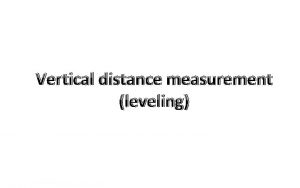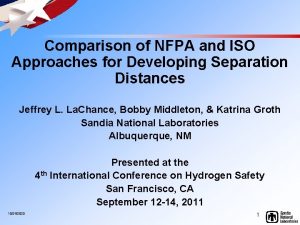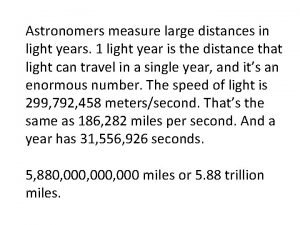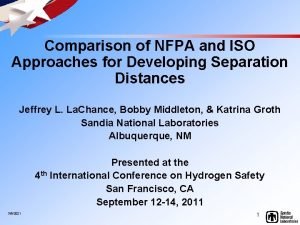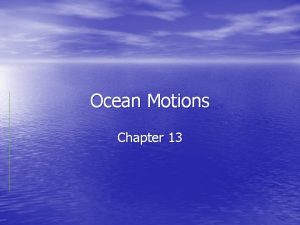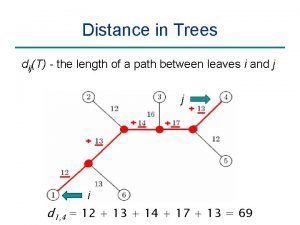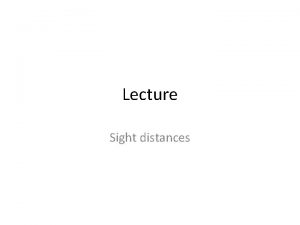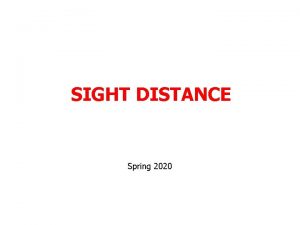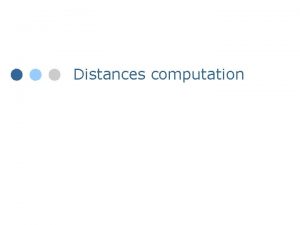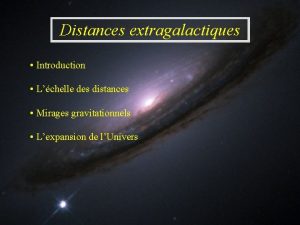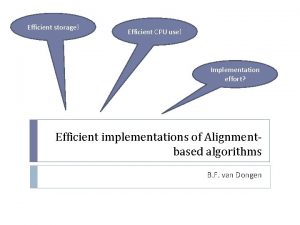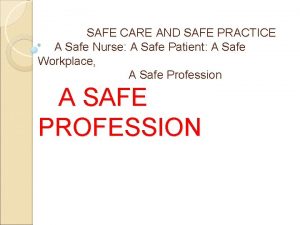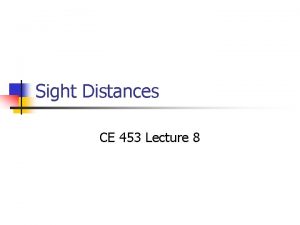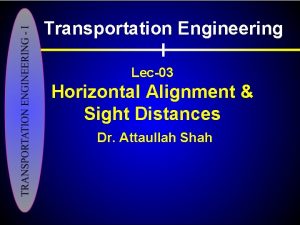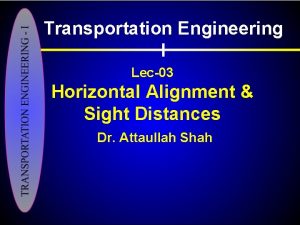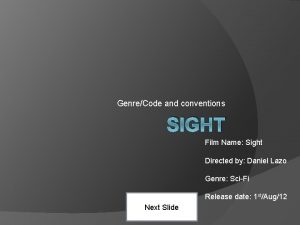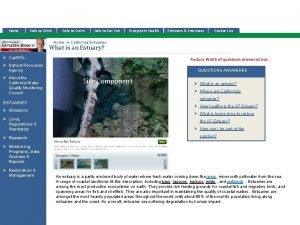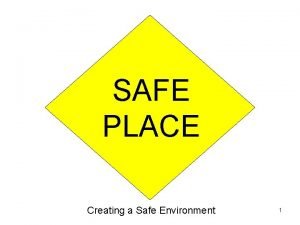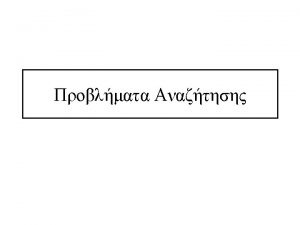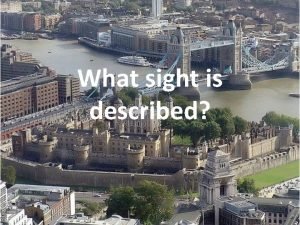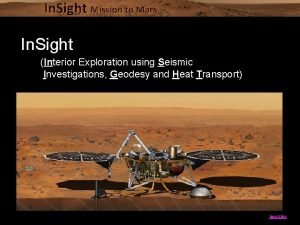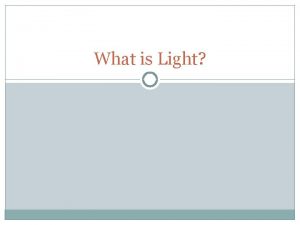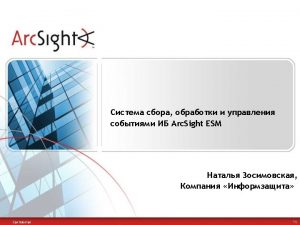Sight Distances Sight Distances The safe and efficient






















- Slides: 22

Sight Distances

Sight Distances � The safe and efficient operation of vehicles on the road depends very much on the visibility of the road ahead of the driver. � Thus the geometric design of the road should be done such that any obstruction on the road length could be visible to the driver from some distance ahead. This distance is said to be the sight distance.

Types of sight distance � Sight distance available from a point is the actual distance along the road surface, over which a driver from a specified height above the carriage way has visibility of stationary or moving objects. sight distance situations considered for design are: � Stopping sight distance (SSD) or the absolute minimum sight distance � Intermediate sight distance (ISD) is the defined as twice SSD � Overtaking sight distance (OSD) for safe overtaking operation � Head light sight distance is the distance visible to a driver during night driving under the illumination of head light

Factors The computation of sight distance depends on: Ø Reaction time of the driver Ø Speed of the vehicle Ø Efficiency of brakes Ø Frictional resistance between the tire and the road Ø Gradient of the road

Reaction time of the driver � Reaction time of a driver is the time taken from the instant the object is visible to the driver to the instant when the brakes are applied. � Many of the studies shows that drivers � require about 1. 5 to 2 seconds under normal conditions. � However taking into consideration the variability of driver characteristics, a higher value is normally used in design

Speed of the vehicle � The speed of the vehicle very much affects the sight distance. � Higher the speed, more time will be required to stop the vehicle. Hence it is evident that, as the speed increases, sight distance also increases.

Efficiency of brakes � The efficiency of the brakes depends upon the age of the vehicle, vehicle characteristics etc. If the brake efficiency is 100%, the vehicle will stop the moment the brakes are applied. � But practically, it is not possible to achieve 100% brake efficiency. � Therefore it could be understood that sight distance required will be more when the efficiency of brakes are less. � Also for safe geometric design, we assume that the vehicles have only 50% brake efficiency.

Frictional resistance between the tire and the road � The frictional resistance between the tire and road plays an important role to bring the vehicle to stop. � When the frictional resistance is more, the vehicles stop immediately. Thus sight required will be less. � The value of longitudinal friction in between 0. 35 to 0. 4.

Gradient of the road � Gradient of the road also affects the sight distance. While climbing up a gradient, the vehicle can stop immediately. Therefore sight distance required is less. � While descending a gradient, gravity also comes into action and more time will be required to stop the vehicle. Sight distance required will be more in that case.

Stopping sight distance � SSD is the minimum sight distance available on a highway at any spot having sufficient length to enable the driver to stop a vehicle traveling at design speed, safely without collision with any other obstruction. � SSD is made up of two components: (1) Braking Distance and (2) Perception-Reaction Time


Criteria for Sight Distance � Driver eye height: for passenger vehicle’s = 3. 5 feet above surface � Height of object in roadway = 2 feet (SSD) � Height of opposing vehicle = 3. 5 feet (PSD)

� deceleration rate of 11. 2 feet/second 2

PASSING SIGHT DISTANCE � Passing sight distance considerations are limited to 2 -lane, 2 -way highways. On these facilities, vehicles may overtake slower moving vehicles.

Cont. . , � Passing sight distance for passenger cars is measured from a 3. 5 feet (1. 080 m) height of eye to a 3. 5 feet (1. 080 m) height of object. � The 3. 5 feet (1. 080 m) height of object allows the opposing driver to see the top of a typical passenger car. � The recommended value of truck driver eye height for design is 7. 6 feet (2. 330 m) above the roadway surface.

INTERSECTION SIGHT DISTANCE (ISD) � In general, ISD refers to the corner sight distance available in intersection quadrants that allows a driver approaching an intersection to observe the actions of vehicles on the crossing leg(s).

Cont. . , � The height of eye for passenger cars is assumed to be 3. 5 ft (1. 080 m) above the surface of the road. � The height of object (approaching vehicle on the major road) is also assumed to be 3. 5 ft (1. 080 m). � An object height of 3. 5 ft (1. 080 m) assumes that a sufficient portion of the oncoming vehicle must be visible to identify it as an object of concern by the minor road driver

Cont. . , � The sight distance should be provided such that the drivers on either side should be able to see each other. � Design of sight distance at intersections may be used on three possible conditions: � Enabling approaching vehicle to change the speed � Enabling approaching vehicle to stop � Enabling stopped vehicle to cross a main road


Decision Sight Distance � The available sight distance on a highway needed to detect an unexpected or otherwise difficult-to-perceive information in a roadway environment

Cont. . , � Decision sight distance values are greater than stopping sight distance values because they give the driver an additional margin for error and afford sufficient length to maneuver at the same or reduced speed rather than to just stop

Cont. . , � Consider decision sight distances at locations where there is high likelihood for driver error in information reception, decision making, or control actions. � If site characteristics and budget allow, locate these highway features where decision sight distance can be provided. If this is not practicable, use suitable traffic control devices and positive guidance to give advanced warning of the conditions.
 Productively efficient vs allocatively efficient
Productively efficient vs allocatively efficient Productively efficient vs allocatively efficient
Productively efficient vs allocatively efficient C b a d
C b a d Allocative efficiency vs productive efficiency
Allocative efficiency vs productive efficiency Allocative efficiency vs productive efficiency
Allocative efficiency vs productive efficiency Safe feed safe food
Safe feed safe food Safe people safe places
Safe people safe places Heights and distances
Heights and distances The elevation of a point is the vertical distance
The elevation of a point is the vertical distance It is the distance covered per unit of time
It is the distance covered per unit of time Nfpa separation distances
Nfpa separation distances Astronomers measure large distances in light years
Astronomers measure large distances in light years Easterlies
Easterlies Hexagon agility test component of fitness
Hexagon agility test component of fitness Nfpa separation distances
Nfpa separation distances Winds that blow over longer distances build up bigger
Winds that blow over longer distances build up bigger Gas particles are separated by relatively large distances
Gas particles are separated by relatively large distances The furthest distance i've travelled
The furthest distance i've travelled Far distances
Far distances Ted likes to run long distances
Ted likes to run long distances Images of weather systems on television come from *
Images of weather systems on television come from * Tree distances i
Tree distances i Wind is horizontal movement of air
Wind is horizontal movement of air








